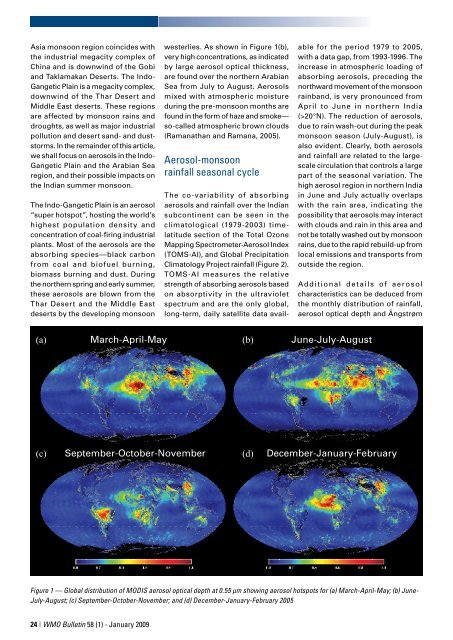Weather, climate and the air we breathe - WMO
Weather, climate and the air we breathe - WMO
Weather, climate and the air we breathe - WMO
You also want an ePaper? Increase the reach of your titles
YUMPU automatically turns print PDFs into web optimized ePapers that Google loves.
Asia monsoon region coincides with<br />
<strong>the</strong> industrial megacity complex of<br />
China <strong>and</strong> is downwind of <strong>the</strong> Gobi<br />
<strong>and</strong> Taklamakan Deserts. The Indo-<br />
Gangetic Plain is a megacity complex,<br />
downwind of <strong>the</strong> Thar Desert <strong>and</strong><br />
Middle East deserts. These regions<br />
are affected by monsoon rains <strong>and</strong><br />
droughts, as <strong>we</strong>ll as major industrial<br />
pollution <strong>and</strong> desert s<strong>and</strong>- <strong>and</strong> duststorms.<br />
In <strong>the</strong> remainder of this article,<br />
<strong>we</strong> shall focus on aerosols in <strong>the</strong> Indo-<br />
Gangetic Plain <strong>and</strong> <strong>the</strong> Arabian Sea<br />
region, <strong>and</strong> <strong>the</strong>ir possible impacts on<br />
<strong>the</strong> Indian summer monsoon.<br />
The Indo-Gangetic Plain is an aerosol<br />
“super hotspot”, hosting <strong>the</strong> world’s<br />
highest population density <strong>and</strong><br />
concentration of coal-firing industrial<br />
plants. Most of <strong>the</strong> aerosols are <strong>the</strong><br />
absorbing species—black carbon<br />
from coal <strong>and</strong> biofuel burning,<br />
biomass burning <strong>and</strong> dust. During<br />
<strong>the</strong> nor<strong>the</strong>rn spring <strong>and</strong> early summer,<br />
<strong>the</strong>se aerosols are blown from <strong>the</strong><br />
Thar Desert <strong>and</strong> <strong>the</strong> Middle East<br />
deserts by <strong>the</strong> developing monsoon<br />
2 | <strong>WMO</strong> Bulletin 58 (1) - January 2009<br />
<strong>we</strong>sterlies. As shown in Figure 1(b),<br />
very high concentrations, as indicated<br />
by large aerosol optical thickness,<br />
are found over <strong>the</strong> nor<strong>the</strong>rn Arabian<br />
Sea from July to August. Aerosols<br />
mixed with atmospheric moisture<br />
during <strong>the</strong> pre-monsoon months are<br />
found in <strong>the</strong> form of haze <strong>and</strong> smoke—<br />
so-called atmospheric brown clouds<br />
(Ramanathan <strong>and</strong> Ramana, 2005).<br />
Aerosol-monsoon<br />
rainfall seasonal cycle<br />
The co-variability of absorbing<br />
aerosols <strong>and</strong> rainfall over <strong>the</strong> Indian<br />
subcontinent can be seen in <strong>the</strong><br />
climatological (1979-2003) timelatitude<br />
section of <strong>the</strong> Total Ozone<br />
Mapping Spectrometer-Aerosol Index<br />
(TOMS-AI), <strong>and</strong> Global Precipitation<br />
Climatology Project rainfall (Figure 2).<br />
TOMS-AI measures <strong>the</strong> relative<br />
strength of absorbing aerosols based<br />
on absorptivity in <strong>the</strong> ultraviolet<br />
spectrum <strong>and</strong> are <strong>the</strong> only global,<br />
long-term, daily satellite data avail-<br />
able for <strong>the</strong> period 1979 to 2005,<br />
with a data gap, from 1993-1996. The<br />
increase in atmospheric loading of<br />
absorbing aerosols, preceding <strong>the</strong><br />
northward movement of <strong>the</strong> monsoon<br />
rainb<strong>and</strong>, is very pronounced from<br />
April to June in nor<strong>the</strong>rn India<br />
(>20°N). The reduction of aerosols,<br />
due to rain wash-out during <strong>the</strong> peak<br />
monsoon season (July-August), is<br />
also evident. Clearly, both aerosols<br />
<strong>and</strong> rainfall are related to <strong>the</strong> largescale<br />
circulation that controls a large<br />
part of <strong>the</strong> seasonal variation. The<br />
high aerosol region in nor<strong>the</strong>rn India<br />
in June <strong>and</strong> July actually overlaps<br />
with <strong>the</strong> rain area, indicating <strong>the</strong><br />
possibility that aerosols may interact<br />
with clouds <strong>and</strong> rain in this area <strong>and</strong><br />
not be totally washed out by monsoon<br />
rains, due to <strong>the</strong> rapid rebuild-up from<br />
local emissions <strong>and</strong> transports from<br />
outside <strong>the</strong> region.<br />
Additional details of aerosol<br />
characteristics can be deduced from<br />
<strong>the</strong> monthly distribution of rainfall,<br />
aerosol optical depth <strong>and</strong> Ångstrøm<br />
(a) March-April-May (b) June-July-August<br />
(c) September-October-November (d) December-January-February<br />
Figure 1 — Global distribution of MODIS aerosol optical depth at 0.55 μm showing aerosol hotspots for (a) March-April-May; (b) June-<br />
July-August; (c) September-October-November; <strong>and</strong> (d) December-January-February 2005

















